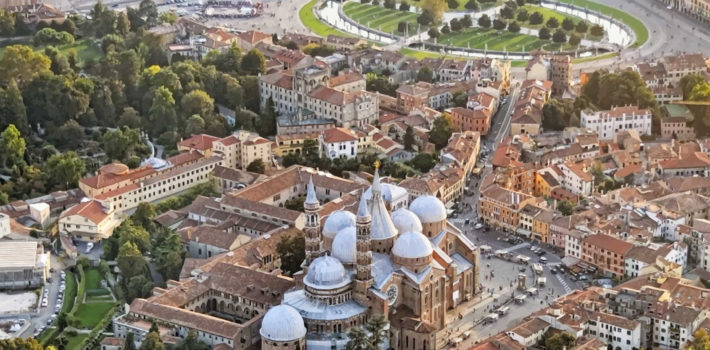Padua
Padua, the “città dotta” or “city of learning” of the Veneto Region, is a place famous for its hospitality,
culture and entertainment. This reputation is due to the presence of one of the oldest Universities in Italy, where such illustrious persons as Galileo Galilei once taught, and home of the perfectly preserved ancient Operating Theatre.
Padova, Walled Town.
Of the city walls built in the Middle Ages from 1195 to bound the ancient Roman island, and of its subsequent extensions there remain some precious examples (including 3 gates), while the city walls built in the Renaissance, in the first half of the Sixteenth century, are almost entirely preserved for a length of 11 km roughly, with 20 ramparts and 6 gates left. The Renaissance city walls were built after the siege of Padua in 1509, when the imperial troops of Maximilian of Austria took the town during the war of the League of Cambrai. The town was freed immediately, but the risk it had run led the Senate of Venice to order that the city walls be rebuilt totally. Works started in 1523 under the direction of Bartolomeo d’Alviano, general captain in the Serenissima Republic, then continued under Michele Sanmicheli and were concluded in 1544. According to the contemporaries this complex defensive system based on impressive walls and ramparts, an outstanding example of the military engineering of the time, made of Padua an impregnable town.
History.
“Antenor, from the midst of Grecian hosts, Could pass secure, and pierce th’ Illyrian coasts, Where, rolling down the steep, Timavus raves And thro’ nine channels disembogues his waves. At length he founded Padua’s happy seat, And gave his Trojans a secure retreat; There fix’d their arms, and there renew’d their name, And there in quiet rules, and crown’d with fame.”
Virgil, Aeneid, I, 242-249
The Greek poet Virgil celebrates with these verses the legend that speaks of Antenor as the mythical founder of Padua. The historical Padua was actually founded over 3000 years ago, during the Paleoveneti age, when the old Veneti people were famous thanks to their excellent breed of horses. In the year 45b.C. the town became a Roman Municipium. Thanks to thriving commerce, fruitful land and abundance of waterways, Patavium was one of the most important and powerful centres of the Roman Empire. During the Barbarian invasions the town was razed to the ground by command of Langobard king Agilulf (601 A.D.) It was only after the year 1000 that Padua registered an important growth in wealth and power, and new imposing religious and civil buildings, such as the Cathedral, the Commune Palaces, towers and defensive walls were built. The 13th and the 14th century marked a period of extraordinary economic and cultural liveliness and ardour, which left great evidences in town: the medioaeval walls, the foundation of the University, the Ragione Palace, the Basilica of st. Anthony and many others. The Trecento, historically characterized by the ruling of the Seigneury of the Da Carrara family, is considered Padua Golden Age: the art panorama was dominated by Giotto and his followers and the city was the most important centre of artistic production in medieval Europe. In 1405 the Da Carrara Seigneury terminated and Padua passed under Venetian rule. Venice fortified Padua with new walls, increased the power of the University, and the venetian nobility invested their capitals on the paduan land, where beautiful villas were erected. The decadence of the Serenissima (1797) and the upcoming of the Napoleonic imperialism put an end to one of the most extraordinary historical, artistical and cultural ages of Europe. The French and the Austrian dominations, and the two World Wars produced a long period of economic and cultural standstill, from which Padua, as the rest of Veneto, recovered with a new and reinforced conscioussness starting from the second half of the 20th century. Today Padua is one of the main economic centres of Veneto and of Italy, an important motorway, railway and waterway junction, which connects Italy with the rest of Europe, and last but not least a beautiful city of art and culture.
Airports:
- Venezia (48 Km)
- Treviso (65 Km)
- Bologna (120 Km)
- Verona (100 Km)
Titolare di Autoservizi dei Colli








